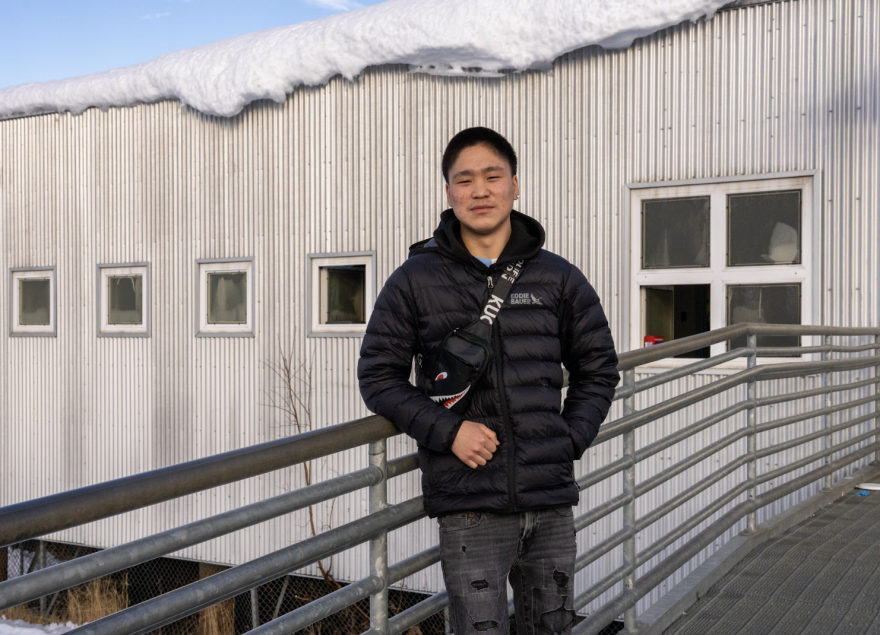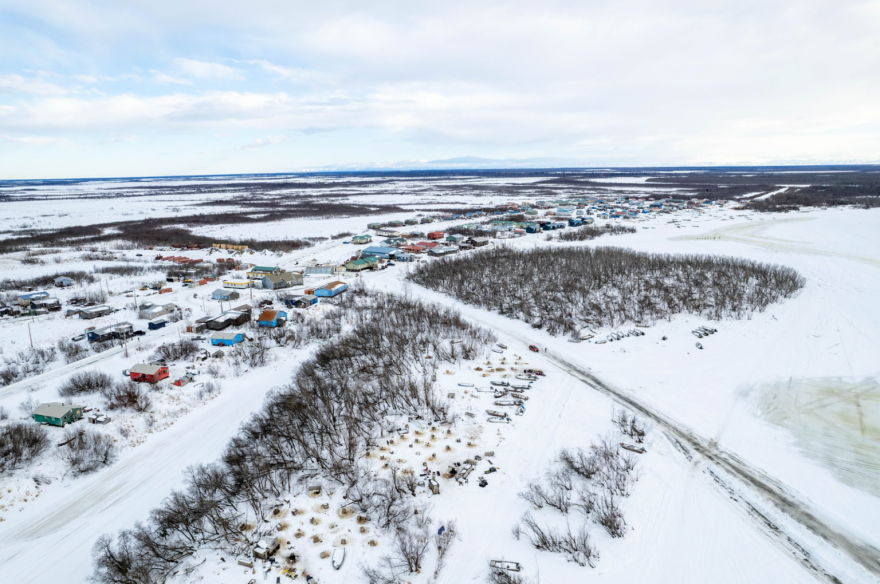This story was produced by KYUK and Northern Journal.
Charlie Chingliak is a budding high school basketball player in the Western Alaska Native village of Akiachak, and he looks the part — sporting two stud earrings in each ear and a stylish hoodie during a recent school day.
But a few nights a week, you can find the 16-year-old not on the basketball court, not hanging with friends or studying at home, but on a sled.
Specifically, one being pulled along a trail by his dog team, as a headlamp-sporting Chingliak soaks up the night air and takes in the dulcet tones of Kendrick Lamar through his ear buds.

Chingliak is not even the fastest teen musher in Akiachak.
Schouviller Wassillie Jr. won last year’s Akiak Dash, a short-distance race along the Kuskokwim River, and the 17-year-old used his winnings to buy high-pedigree sled dogs for $2,000 apiece from a pair of Iditarod mushers.
High school boys in Akiachak can “forget the muscle cars,” said Barron Sample, principal of the village’s school. “You get the muscle dogs,” he said.

Welcome to the mushing-crazed Kuskokwim Delta — the one region of Alaska where the sport of mushing seems to be thriving, not just surviving.
Elsewhere in the state, grim headlines about dog sled racing warn of diminishing participation and sponsors fleeing the sport.
On the Kuskokwim last weekend, teams from villages up and down the river vied for huge cash prizes in a pair of races that highlighted how the region has become a stronghold of the sport.
Casual fans of sled dog racing might have noticed that the winner of the weekend’s marquee Kuskokwim 300 race, also known as the K300, was local hero Pete Kaiser, from the Delta’s regional hub of Bethel.
But 11 teams from Akiachak alone contested the lower-profile, 65-mile Dash from Bethel to the nearby village of Akiak and back.

“This seems to be the only growing mushing community in the state,” said Lev Shvarts, an Iditarod veteran from Willow, north of Anchorage, who competed in this year’s K300. He added: “I don’t know how to explain it. I just see it and I like being a part of it.”
Locals agree that a driving force behind mushing’s persistence in the region is the Kuskokwim 300 — the name of not just the 300-mile mile race but of a nonprofit that organizes other mushing events like the Dash and the Bogus Creek 150, set for later this month.
Each of those races pays out substantial cash prizes not just to podium finishers but to teams much farther down in the standings, in amounts that have risen with growing sponsorship in recent years.
The payments serve as powerful motivators to mushers and also are essential supports for kennels in an area where dog food must be shipped in at steep prices.
Of the 16 mushers who competed in this year’s Akiak Dash — all of whom were Kuskokwim locals, including a 15-year-old from the village of Napaskiak — just one was out of the money. The 15th-placed finisher earned a $2,200 paycheck, while winner Raymond Alexie of Kwethluk took home $7,000.

“Seems like every year we get one more sponsor to make a pretty substantial increase or join the fold,” said Paul Basile, Kuskokwim 300 race manager and the nonprofit’s sole full-time employee. “They’re mostly Alaskan companies that have a presence in the region. And associating themselves with a popular event is just good marketing for them.”
This year’s 300-mile race was the 46th annual. Its founding, in 1980, came at a moment when old-timers say that mushing was waning in the Kuskokwim Delta, as snowmachines replaced the dog teams that locals had long relied upon.

Mo Napoka, a 71-year-old retired Indigenous language teacher in the Kuskokwim River village of Tuluksak, said he learned how to mush from his father, who ran dogs for his whole life.
“We’d use ’em to go spring camping. We’d use ’em for getting wood for the houses, and racing too,” said Napoka, who still maintains a kennel in Tuluksak.
The original K300 was the brainchild of Myron Angstman, an attorney who had moved from Minnesota to Bethel to work as the community’s first public defender and developed a mushing side habit.
Angstman had raced the 1,000-mile Iditarod but thought it took a little too long, “if a guy had a job.” So he went home and announced that the Delta should put on its own race.
“Everybody jumped in and it was a complete community, volunteer event,” Angstman said in an interview at Monday’s K300 musher’s banquet. “And most of that community event has survived.”

Volunteers still power the K300, with local doctors, nurses and even a local Superior Court judge and his kids pitching in last weekend. They run checkpoints, live streams and a complex dog delivery system for the races.
Veteran mushers from events like the Iditarod fly in from the road system with their dogs to compete for the $30,000 first prize in the 300-mile event. Each of the 17 teams that finished this year received at least $5,000 in prize money.
Shvarts said the race is far cheaper than the Iditarod, which commands a $4,000 entry fee; the K300 plus a required membership fee cost $500, with all but $100 refunded to mushers who actually show up on the start line.
“I can run a K300 with a smaller kennel, which means less hours training, which means less dog food,” Shvarts said. “And the paycheck is still very sizable.”
It’s not just the visiting mushers who compete in the 300-mile race, though.
Kaiser, the Bethel resident who won this year’s event, now has nine K300 titles. Mike Williams Jr., who lives in the Kuskokwim village of Akiak, was fourth, just a few minutes off the podium.

Another musher from higher up on the river, Isaac Underwood, put his dogs in boxes in his home village of Crooked Creek and towed them 200 miles by snowmachine down the Kuskokwim to the starting line — a journey that took 17 hours.
Williams, 39, said he’s been inspired by some of the younger mushers whom he now encounters on training runs — including Chingliak, the 16-year-old who also happens to be Williams’ nephew.
“It lifts me up. I’m not one of the young guys any more,” Williams said. “I used to be one of the young guys. Now I’m one of the old guys.”
Chingliak said he got a couple of dogs from Williams and started his own small team when he was 14. He now has 10 dogs and placed 12th in last weekend’s Dash.
In an interview Monday at the Akiachak school principal’s office, he said he does it for the feeling.
“I love mushing,” he said. “It just makes me fulfilled — the nature out there, beautiful, calm.”
Between basketball, running his dog team and school, “my whole days are, like, busy,” Chingliak said. But, he added, “I get my work done.”
Mushers like Chingliak appear set to sustain the sport along the Kuskokwim for years to come — though one source of anxiety is the region’s climate.
Warmth and poor snow conditions interfered with training and forced multiple local mushers to abandon plans to compete in this year’s 300-mile race. And long-term climatic predictions are grim.
“This zone has always been subject to mid-winter rains. And it’s becoming way more prevalent,” said Angstman, the K300 founder. “It discourages people.”
Still, the mushers visiting the Kuskokwim for the first time last weekend seemed delighted to experience the region’s enthusiasm for their craft. Especially Emily Robinson, a 17-year-old from Alaska’s Interior who’s won three junior editions of the Iditarod.

Robinson, who finished sixth in the 300-mile race and won the Rookie of the Year award, acknowledged that her sport’s future feels a little shaky on the road system.
But along the Kuskokwim, she added, it’s “on a completely different level.” Young racers and veterans are competing, she said, plus a huge community of volunteers supports them.
“There’s just going to be this pocket of Alaska, no matter what happens in the rest of the state with dog mushing — the Kusko’s just going to continue to happen every single year,” she said. “It’s just going to stay alive forever.”
Nathaniel Herz welcomes tips at natherz@gmail.com or (907) 793-0312. This article was originally published in Northern Journal, a newsletter from Herz, and KYUK. Subscribe to Northern Journal at this link.

